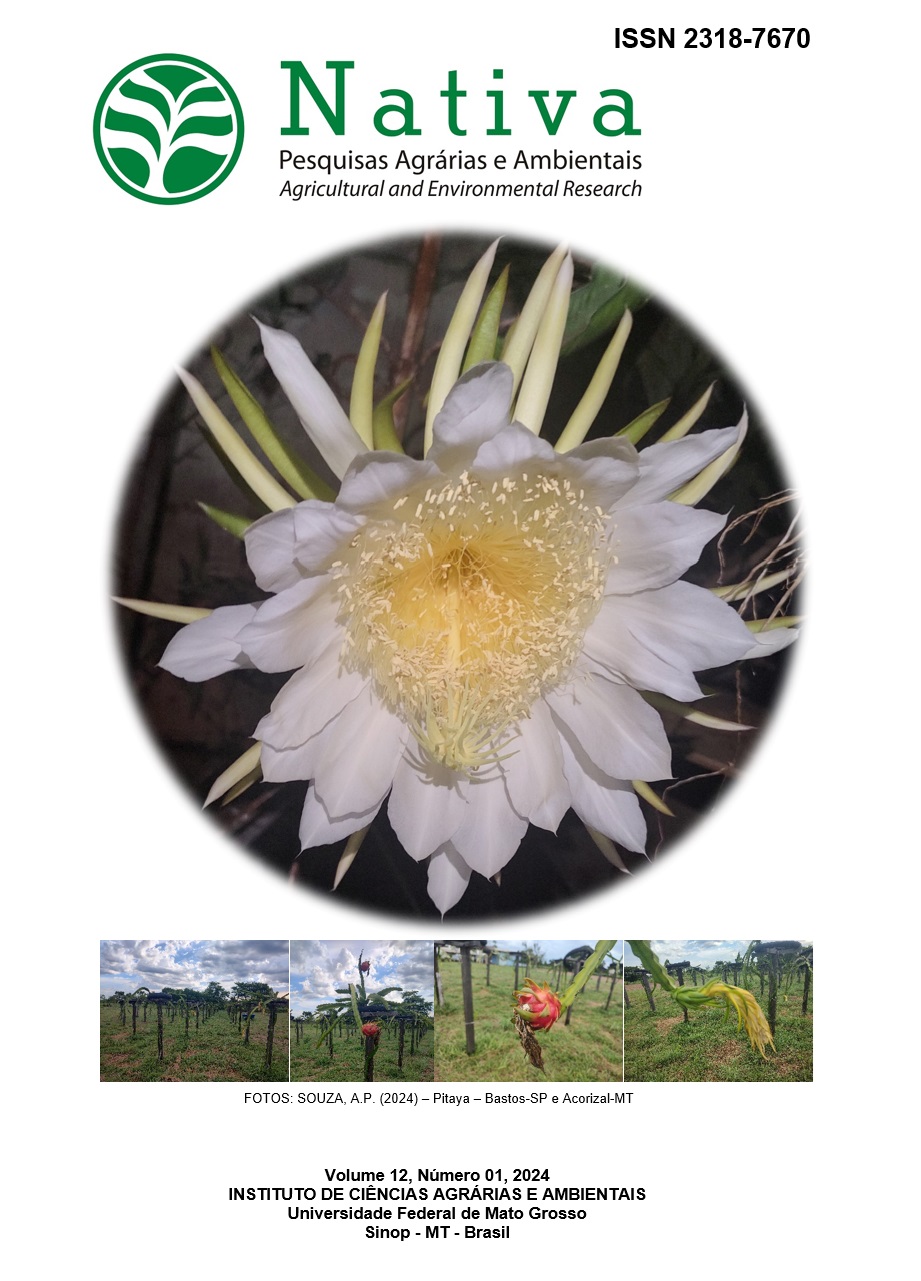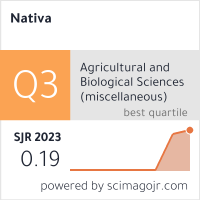SEEDING RATE AND NITROGEN FERTILIZER LEVEL FOR BLACK BARLEY UNDER RAIN-FED CONDITIONS
DOI:
https://doi.org/10.31413/nat.v12i1.16993Palavras-chave:
Hordeum distichum L., plant density, urea fertilization, rain-fed agricultureResumo
Increasing grain production yield is crucial to achieving profitable production systems. The optimal seeding rate and nitrogen fertilization at the right dose are substantial production factors for a higher barley crop yield, especially in rainfed conditions. The experiment aimed to determine the optimal black barley seeding and nitrogen fertilizer rate under rainfed conditions in Kirkuk district, northern Iraq. The agronomic characteristics of black barley were evaluated at seeding rates (200, 300 and 400 seeds m-2) and different rates of nitrogen applications (0, 40 and 80 kg N ha-1). These seeding rates at 300 and 400 seeds m-2 significantly affect Spikes m-2, straw yield and biological yield compared to 200 seeds m-2. Most studied traits were affected significantly by nitrogen fertilizer, where 80 kg N ha-1 recorded the highest value in spike length, m-2, grains spike-1, grain yield, biological yield and harvest index compared to 40 kg N ha-1. Moreover, seeding rate x N fertilization had a significant influence on most of the studied traits, where 300 seeds m-2 × 80 kg N ha-1 significantly affected spike length, spikes m-2, grains spike-1, grain yield and harvest index, while straw yield and biological yield responded significantly to 400 seeds m-2 × 40 kg N ha-1. The most measured traits, especially grain yield, were impacted by nitrogen application rather than seeding rates. In this region, black barley should be sown with 300 seeds m-2 with an application of 80 kg N ha-1 to obtain better grain yields under rainfed conditions.
Keywords: Hordeum distichum L.; plant density; urea fertilization; rain-fed agriculture.
Taxa de semeadura e nível de fertilizante nitrogenado para cevada preta (Hordeum distichum L.) sob condições de sequeiro
RESUMO: O aumento do rendimento da produção de grãos é crucial para a obtenção de sistemas de produção rentáveis. A taxa ótima de semeadura e a fertilização com nitrogênio na dose certa são fatores de produção substanciais para um maior rendimento da cultura da cevada, especialmente em condições de sequeiro. O experimento teve como objetivo determinar a taxa ideal de semeadura e de fertilizante de nitrogênio para cevada preta, sob condições de sequeiro no distrito de Kirkuk, norte do Iraque. Avaliou-se as características agronômicas da cevada preta em taxas de semeadura (200, 300 e 400 sementes m-2) e diferentes doses de aplicação de nitrogênio (0, 40 e 80 kg N ha-1). As taxas de semeadura de 300 e 400 sementes m-2 afetam significativamente o número de espigas m-2, a produtividade de palha e a produtividade biológica em comparação com 200 sementes m-2. A maioria das características agronômicas estudadas foram significativamente afetadas pela adubação nitrogenada, sendo que 80 kg N ha-1 gerou os maiores valores em comprimento de espiga m-2, grãos espiga-1, produtividade de grãos, rendimento biológico e índice de colheita, quando comparado com 40 kg N ha-1. Além disso, a interação taxa de semeadura x adubação com N, influencia significativamente na maioria das características agronômicas, visto que 300 sementes m-2 × 80 kg N ha-1 possibilitaram melhores respostas quanto ao comprimento de espigas, espigas m-2, grãos espiga-1, produtividade de grãos e colheita índice; todavia, a produtividade de palha e a produtividade biológica foram melhores na interação de 400 sementes m-2 × 40 kg N ha-1. A maioria das características medidas, especialmente o rendimento de grãos, foram impactadas pela aplicação de nitrogênio e não pelas taxas de semeadura. Nessa região, a semeadura de cevada preta deve ser com 300 sementes m-2 com aplicação de 80 kg N ha-1 para obter melhores rendimentos de grãos sob condições de sequeiro.
Palavras-chave: Hordeum distichum L.; densidade de plantas; fertilização com uréia; agricultura dependente da chuva.
Referências
AL-DULAIMY, B. H. A.; AL-JANABI, W. A. H.; AL-DULAIMY, Y. A. Effect of the seeding rates in grain yield and its quality for four barley cultivars. Journal of Anbar for Agricultural Science, v. 13, n. 1, p. 203-212, 2015.
AL-FREEH, L. M.; OBEIDI, R. H.; AL-ZERGAWY, M. A. Effect of seeding rates and number of cutting on growth and yield of Barley (Hordeum vulgare L.) in Basrah. Thi-Qar University Journal for Agricultural Researches, v. 4, n. 2, p. 313-324, 2015.
ALRIJABO, A. A.; ALAMIN, M. W. T. Effect of row spacing in zero tillage planting system on growth. Yield and its components of two cultivars of barley. Kirkuk University Journal for Agricultural Sciences, v. 10, n. 1, p. 129-136, 2019.
AMARJEET, S. B.; KUMAR, J.; KUMAR, M.; SHARMA, R.; KAUSHIK, P. Effect of sowing date, seed rate and row spacing on productivity and profitability of barley (Hordeum vulgare) in north India. Preprints, 2020. https://doi.org/10.20944/preprints202001.0380.v1.
AWULACHEW, M. T. Productivity and Grain quality of Holker, Ibon and Franka malt barley (Hordeum vulgare L.) varieties to the nitrogen fertilizer rate at the central highland of Arsi, Ethiopia. Journal of eSciences, v. 2, n. 12, p. 1-16, 2019.
BEKELE, S.; YOSEPH, T.; AYALEW, T. Growth, protein content, yield and yield components of malt barley (Hordeum vulgare L.) varieties in response to seeding rate at Sinana District, Southeast Ethiopia. International Journal of Applied Agricultural Sciences, v. 6, n. 4, p. 61-71, 2020. https://doi.org/10.11648/j.ijaas.20200604.12
CSO_Central Statistical Organization. Wheat and barley production 2020. Directorate of Agricultural Statistics. Ministry of Planning, Iraq, 2020.
DUBEY, S. N.; TIWARI, A.; PANDEY, V. K.; SINGH, V.; SINGH, G. Effect of nitrogen levels and its time of application on growth parameters of barley (Hordeum vulgare L.). Journal of Pharmacognosy and Phytochemistry, v. 7, n. 1, p. 333-338, 2018a.
DUBEY, S. N.; TIWARI, A.; SINGH, V.; PANDEY, V. K.; SINGH, G. Effect of nitrogen levels and its time of application on yield attributes, yield and economics of barley (Hordeum vulgare L.). International Journal of Current Microbiology and Applied Sciences, v. 7, p. 695-1705, 2018b. https://doi.org/10.20546/ijcmas.2018.701.205
FAOSTAT. Production of barley by region and country. 2020. http://www.fao.org/faostat/en/#data/qc
GADRI, K.; MOHAMMADI, S.; DADASHI, M. R.; MAJIDI, A. The response of barley (Hordeum vulgare L.) genotypes to nitrogen fertilizer application under normal irrigation and drought stress conditions. Environmental Stresses in Crop Sciences, v. 13, n. 1, p. 73-84, 2020. https://doi.org/10.22077/escs.2018.1375.1296.
GUDDISA, B.; GEREMA, G.; BEDADA, G.; DEBELA, M.; MERGA, F. Effect of NPS and nitrogen fertilizer rate on yield and yield components of food barley (Hordeum vulgare L.) in Western Oromia, Ethiopia. Sciences, v. 9, n. 2, p. 40-45, 2021.
HABIYAREMYE, C.; SCHROEDER, K. L.; REGANOLD, J. P.; WHITE, D.; PACKER, D.; MURPHY, K. M. Effect of nitrogen and seeding rate on β-glucan, protein, and grain yield of naked food barley in no-till cropping systems in the Palouse region of the Pacific Northwest. Frontiers in Sustainable Food Systems, v. 5, e663445, 2021. https://doi.org/10.3389/fsufs.2021.663445
HAYAWI, J. A. Effect of sowing date and Treflan herbicide on the growth and yield of local barley, Hordeum vulgare. Journal Of Kirkuk University for Agricultural Sciences, v. 13, n. 4, p. 355-363, 2022.
HECHT, V. L.; TEMPERTON, V. M.; NAGEL, K. A.; RASCHER, U.; POSTMA, J. A. Sowing density: a neglected factor fundamentally affecting root distribution and biomass allocation of field-grown spring barley (Hordeum vulgare L.). Frontiers in Plant Science, v. 7, e944, 2016. https://doi.org/10.3389/fpls.2016.00944.
KADHIM, S. H. Increasing barley (Hordeum vulgare L.) competitive ability to collateral weeds by different seed rating and some herbicides. Plant Archives, v. 20, sup. 2, p. 596-600, 2020.
KHUMALO, M. Effect of planting density and nitrogen application on grain quality and yield of three barley (Hordeum vulgare L.) cultivars planted in the Western Cape Province of South Africa. MSc. Thesis, Faculty of Applied Science at the Cape Peninsula, University of Technology, South Africa, 2019.
KOHISTANI, A. W.; CHOUDHARY, A. K. Effect of varying nitrogen levels on growth, development and yield of winter barley (Hordeum vulgare L.) in semi-arid region of Southern Afghanistan. Annals of Agricultural Research New Series, v. 40, n. 1, p. 29-35, 2019.
LEGASIE, C. H. B. Responses of yield and yield components of food barley (Hordeum vulgare L.) to seeding and NPS rates in Farta District, Northwestern Ethiopia. MSc. Thesis, College of Agriculture and Environmental Sciences, Bahirdar University, Bahir Dar, Ethiopia, 2019.
MANSOOR, H. N.; JEBER, B. A. Effect of cutting dates and different levels of Nitrogen on the yield of green feed and grain yield for barley crop (Hordeum vulgare L.). Plant Archives, v. 20, n. 1, p. 1417-1422, 2020.
PARASHAR, A.; KUMAR, S.; GUPTA, S.; DOGRA, P.; TYAGI, B. S. Response of malt barley (Hordeum vulgare L.) varieties to nitrogen and sulphur application under Agro-climatic zone IIIa (semi-arid eastern plain zone) of Rajasthan. Journal of Cereal Research, v. 12, n. 1, p. 55-60, 2022a. http://doi.org/10.25174/2582- 2675/2020/85266
PARASHAR, A.; SHARMA, S.; DOGRA, P.; PARASHAR, K.; TYAGI, B. S. Response of malt barley (Hordeum vulgare L.) varieties to different levels of nitrogen and sulphur application under agro-climatic zone IIIa (emi-arid eastern plain zone) of Rajasthan. International Journal of Chemical Studies, v. 8, p. 2059-2062, 2022b. https://doi.org/10.22271/chemi.2020.v8.i4v.9932
SINGH, A. K.; SINGH, B.; PRASAD, G. Influence of sowing times, seed rates and row spacings on physiological studies of barley (Hordeum vulgare L.). Journal of Pharmacognosy and Phytochemistry, v. 9, n. 2, p. 510-513, 2020.
SAS Institute. The SAS system for Windows v. 9.00 SAS Institute Inc., Cary, NC, USA, 2002.
STATISTICAL REPORT NO. 61. Annual statistical data for agricultural activity for year 2020, 2021.
TALIB, M. S.; MANSOOR, H. N.; ABBAS, A.-K. H. H. The effect of mowing dates and different nitrogen levels on yield characteristics of barley (Hordeum vulgare L.). Plant Archives, v. 21, n. 1, p. 104-108, 2021.
TEHULIE, N. S.; ESKEZIA, H. Effects of nitrogen fertilizer rates on growth, yield components and yield of food Barley (Hordeum vulgare L.): A Review. Journal of Plant Sciences and Agricultural Research, v. 5, n. 1, e46, 2021.
TEREFE, D.; DESALEGN, T.; ASHAGRE, H. Effect of nitrogen fertilizer levels on grain yield and quality of malt barley (Hordeum Vulgare L.) varieties at Wolmera District, Central Highland of Ethiopia. International Journal of Research Studies in Agricultural Sciences, v. 4, n. 4, p. 29-43, 2018. http://dx.doi.org/10.20431/2454-6224.0404005
TOLESA, T.; ASHAGRE, H.; ABERA, T. Agronomic Performance of food barley (Hordeum vulgare L.) varieties and their response to seed rate at Elfeta District, West Showa Zone, Oromia National Regional State. Journal of Science and Sustainable Development, v. 7, n. 1, p. 20-31, 2019. https://doi.org/10.20372/au.jssd.7.1.2019.093
ZADOKS, J. C. A decimal code for the growth stages of cereals. Current Contents, v. 16, e14, 1985.
Downloads
Publicado
Edição
Seção
Como Citar
Licença
Copyright (c) 2024 Nativa

Este trabalho está licenciado sob uma licença Creative Commons Attribution-NonCommercial 4.0 International License.
Direitos Autorais para artigos publicados nesta revista são do autor, com direitos de primeira publicação para a revista. Em virtude de a aparecerem nesta revista de acesso público, os artigos são de uso gratuito, com atribuições próprias, em aplicações educacionais e não-comerciais.
A artigos publicados nessa revista, podem ser reproduzidos parcialmente ou utilizados como referência por outros autores, desde que seja cita a fonte, ou seja, a Revista Nativa.
Copyright for articles published in this journal are the authors, with first publication rights granted to the journal. The journal shows open access, and articles are free to use, with proper attribution, in educational and non-commercial.
The articles published in this journal may be reproduced in part or used as a reference by other authors, provided that the source is quoted.






